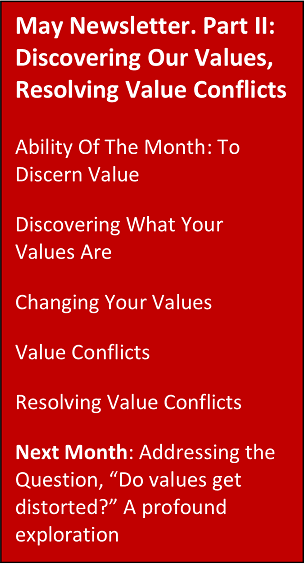Values Part II. Discovering Our Values; Resolving Value Conflicts PDF version
 Last month we defined what values are and explored their importance in our life. This month we will learn how to know what our values are, learn how to change our values, understand what value conflicts are, and learn how to resolve these conflicts.
Last month we defined what values are and explored their importance in our life. This month we will learn how to know what our values are, learn how to change our values, understand what value conflicts are, and learn how to resolve these conflicts.
ABILITY OF THE MONTH: TO DISCERN VALUE
In discernment, we use our mental abilities to think and to analyze, as well as our emotional ability to determine what feels right to us. Utilizing the skill of discernment, we make the distinctions that add to our knowledge of what our values are.
Point of Empowerment: Working with our values utilizes our ability to discern value. We turn our ability into skill with practice.
Practice: To practice discernment, frequently ask yourself: “As I engage in this activity, which of my values am I expressing?”
DISCOVERING WHAT OUR VALUES ARE: HOW CAN YOU KNOW WHAT YOU VALUE?
The process of discovering what our values are has been called values clarification. It is a process of bringing clarity to vague, confused ideas about which values we hold. Our values tend to function at the level below our everyday awareness, in the subconscious mind. But life brings us opportunities to discover our values. Clarity allows us to make precise choices about what we value. Since our values are very important to us, clarity is important to us.
Knowing what our values are allows us to achieve fulfillment by perusing what we value, and to resolve value conflicts, bringing us peace of mind.
Procedure for Achieving Clarity About Values
To know what your values are ask yourself these questions: “What is important to me?”; “What matters to me?” Write down your answers, making a list. For example:
- Fun is important to me.
- Love in my life matters.
- Spending time with my family is important.
- Exercising each day is important.
- Being productive in my work matters.
- Being aware of world events is important.
- Experiencing happiness and joy matters.
Another technique to discover your values is to observe what you spend your time doing and what you focus your attention on. For example:
- I spend a lot of time at work. I value work.
- I watch sports on TV and go to sporting events. I value being entertained by sports.
- I spend little time talking to my spouse. I don’t value communication with my spouse.
- I am happy when I am reading by myself. I value solitary time.
Other questions that can help us reflect on and understand what we value:
- How do we spend our resources of time and energy?
- What relationships do we enjoy and invest our time and energy into?
- What is the frequency of situations where a particular value is at play? For example: How often am I expressing my opinion, which I value very much?
- What do you feel strongly about? What gets you passionate, excited, or angry?
- What actions do you repeatedly perform?
- How often are you in conflict with others? What are these conflicts about, which values?
Point of Empowerment: When we face making an important choice, being aware of our values helps us make an informed, and therefore a powerful and meaningful, choice.
Practice: Bring awareness to your choices by identifying the values being expressed in them.
Prioritizing Values
We may or may not know that we frequently prioritize our values. When we make a choice between two activities or things to do at a certain moment in time, we are prioritizing our values. “Right now food shopping is more important than watching TV.” We usually make these choices without the awareness that we are prioritizing our values.
We experience inner conflict, and the discomfort that conflict generates, when we must make a choice between values that we hold equally. Here the ability to discern value and the skill of prioritizing is “invaluable”. To help with prioritizing you can to use the following practice.
Practice: To establish the priority of values, rate each value on a scale of 1 to 10 asking: “What number would I assign to this value?” Without “trying too hard” allow an answer to come to you. (This kind of answer is an “impression” not a “hard fact”.)
Point of Empowerment: You can us this practice to determine the intensity with which you hold a value. This is useful when you want to increase or decrease that intensity, or when you are finding it hard to change a value because of its intensity.
For example, “On a scale of 1 to 10 how would I rate the importance of writing a monthly newsletter—8.5. How would I rate playing golf—7. I know what my priorities are.”
CHANGING YOUR VALUES
In changing our values, we can eliminate values we no longer hold, add values that we discover are important to us, or reduce or increase the intensity with which we hold a value. Our values also change “by themselves” as we move through our lives.
When We Should We Change Our Values
We should change our values when:
- We grow as a person
- We desire a more fulfilling life
- We want to resolve value conflicts within ourselves
- Our values create unnecessary conflict with important people in our life
- A life crisis forces us to decide what matters the most
Changing Your Values; Technique
Changing values is actually changing our beliefs, the beliefs about what is important to us, about what matters. Changing a belief can be straightforward/easy or complex/hard, depending on the factors in our life that are connected to a particular value. For example, you may value self-assertion, but lack the self-esteem necessary to assert yourself. Below is a process where the belief/value change is relatively straightforward. If you find yourself unable to change a belief/value, you are facing a complex situation that requires a deeper exploration.

Working with Our Beliefs
- Identify the value
- Recognize that it is a belief about what is important, what matters to us.
- Decide if you are going to eliminate values you no longer hold, add values that you discover are important to you, or reduce or increase the intensity with which you hold a value.
- Changes in belief are made with affirmations.
- Eliminating a value, state the affirmation: “(The belief/value under consideration) is no longer of value to me, I no longer hold that value.”
- “Working 12 hours a day is no longer of value to me. I no longer hold that value.”
- “Having my children obey me all the time if no longer of value to me. I no longer hold that value. “
- Adding a value, state the affirmation: “I now believe that (state the value) is of value to me.”
- “I now believe that being productive to advance my career is of value to me.”
- “I now believe that going to graduate school is of value to me.”
- Reducing or increasing the intensity, state the affirmation: “I now believe that—what you are considering—is more important or less important, than it used to be.”
- “I now believe that being financially independent is more important to me than it used to be.”
- “I now believe that exercising 5 hours a day no longer enhances my life and is therefore less important that it used to be.”
- Eliminating a value, state the affirmation: “(The belief/value under consideration) is no longer of value to me, I no longer hold that value.”
- Close your eyes and visualize (imagine) a situation where you are acting on the new belief.
- State “I am imagining leaving work after 9 hours,” and run a “movie” in your mind where this is happening.
- Act on this belief in the situation you visualized.
- “Last Friday I left work after 9 hours.”
- Evaluate the results asking the question: “How effectively did I act on my new value?”
- Repeat the above steps if necessary. Continue to act on your new value.
Point of Empowerment: Stating affirmations is known as programming the subconscious mind. When the subconscious mind has new beliefs, we are prompted to act in ways that express these beliefs. This includes recognizing and utilizing opportunities that present themselves to us, opportunities that are consistent with our beliefs.
VALUE CONFLICTS
In the course of living our lives, having value conflicts is inevitable. It is important to resolve value conflicts because they cause us some degree of pain. (Though being able to tolerate some inner conflict is useful.) Our mental health can be put in jeopardy if this pain is chronic and too intense. In dealing with value conflicts we:
- Recognize that we are having a values conflict.
- Identify the values we are expressing.
- Resolve the conflict by: prioritizing the values, changing the intensity (the quantity) of the values, letting go of one of the values, or being creative to find a resolution (which includes compromising and “taking turns”).
Recognizing Value Conflicts; Identifying Their Specifics
To recognize a value conflict and identify its specifics, we tune into what we are thinking and feeling.
Our thinking is about two things that we want to do but are mutually exclusive. We can’t do them both at the same time and must choose one of them. We ask: “What are the activities and how do they conflict?” Write the answer down if the answer is complex.
Feelings like guilt, confusion and frustration can indicate that a values conflict is present. More serious and/or chronic value conflicts can produce anger, sadness, anxiety, and depression. We ask: “What are our feelings?” Write the feelings down if the answer is complex.
Identify the values we are expressing
To identify the two values you are expressing, answer the question: “How do the activities I am are considering express what I value?” You can consult your list of values to see if any are at play and/or recognize other values that you hold. Write your answer down. In this practice, we are using our ability to discern value.
Resolving value conflicts
To resolve value conflicts we can use the following procedure.
- Consider the two alternative activities
- Choose a conflict resolution strategy: prioritize, change the intensity, let go of one of the values, be creative in finding a resolution, compromise, or take turns.
- Strengthen your choice by acting on your strategy.
These examples illustrate the processes we are referring to.
- I feel guilty because my mother wants my help. (I value being helpful.) But, my friends want to go to the movies. (I value fun.) Since I helped my mother yesterday, I choose going to the movies. (Taking turns)
- Or “On a scale of 1 to 10, how would I rate helping my mother versus going to the movies with my friends? Right now, helping mother is a 4 and going to the movies with my friends is a 6. I choose the value with the higher rating.”
- I can donate money to a political action group or buy a piece of art. (I value political action and supporting artists.) I buy the artwork, since, at this time, supporting the artist is more important to me. (Discerning intensity of value.)
- I feel confused. I want to go skiing (I value adventure.) But, I might not go because I have a tendency to be reckless and could get injured. (I value my health.) I choose to go skiing and ski carefully so as not to get injured. (Creatively integrating values)
- I feel frustrated because I want to lose weight. (I value my health and appearance.) But, I love to eat chocolate. (I value pleasure.) I decide to eat a small amount of chocolate slowly to enjoy its flavor. (Creatively integrating values)
- My parents want me to go to college. (They value education.) I want to earn money now. (I value money). I decide to go to college part time and get a part time job. (Compromising)
- I enjoy vacationing in the mountains. (I value what brings me joy.) My wife enjoys vacationing by the beach. I am willing to go to the beach to make her happy. (I value my wife’s happiness.) This year my priority is my wife’s happiness—the beach; next year—the mountains, as my priority will be my enjoyment. (Establishing priority and taking turns)
- I have fun going out to eat. (I value fun.) I want to save money. (I value planning for the future.) Since these values are of equal weight (intensity) I feel conflicted and agitated. Since I am I entering a new phase of my life, I make eating out less valuable and saving money more valuable.
Point of Empowerment: You can approach clarifying values and resolving value conflicts in the spirit of self-discovery.
Practice: With self-appreciation, add new values that you discover to your list.
This month we have explored more of the complexity of value and valuing. Next month we will explore the question, “Do values get distorted?” In conclusion, let’s take a brief look at the power of valuing in human interaction.

“I value you. You are worthy.” (Building self-worth by communicating value.)

The more you know about how you operate,
the greater your ability to work with your values.
Consult The Operating Manual for the Self.
Let’s unite in developing our human potential. Share this newsletter with others. Please visit our website, IIFSD.org. We invite you to participate, (as suggested in the Participation Menu selection). When you buy The Operating Manual for the Self (manualfortheself.com), you support our vision and mission. When you read The Operating Manual for the Self, you leap forward in your personal self-development and evolution. Copywrite IIFSD.org, May 2017. All rights reserved.
